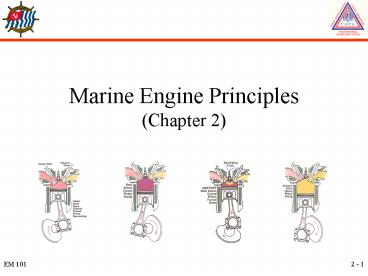Marine Engine Principles Chapter 2 PowerPoint PPT Presentation
1 / 19
Title: Marine Engine Principles Chapter 2
1
Marine Engine Principles(Chapter 2)
2
Overview
- How Engine Work
- Engine Energy Conversion
- Horsepower and Torque
- Displacement and Compression Ratio
- Internal Combustion
- Spark-Ignition, 4-Stroke
- Compression-Ignition, 4-Stroke
- Compression-Ignition, 2-Stroke
- Spark-Ignition, 2-Stroke
3
How Engines Work
- Internal Combustion within closed volume
- Require
- Fuel
- Air (oxygen)
- Source of Ignition
- The fuel burns inside the engine, where the
rapidly expanding hot gases of the burning fuel
act directly on the engines internal components.
4
Engine Energy Conversion
- Basic Support Systems
- Fuel
- Induction
- Ignition
- Cooling
- Lubrication
- Exhaust
- Gas engines are spark-ignition
- Diesel engines are compression-ignition
5
Horsepower and Torque
- Horsepower
- Amount of Work the engine is
doing - Measured in brake horsepower or kilowatts
- Torque
- Rotational Force of the
engine - Measured in pound-feet
6
Displacement
- Total Volume of the engines cylinders measured
between Bottom Dead Center to Top Dead Center
7
Compression Ratio
- Combustion Chamber Volume at Bottom Dead Center
divided by volume at Top Dead Center - Gas engines 81 to 111
- Diesel engines 161 to 251
8
Internal Combustion Engines
- Steps
- Intake (power consumed)
- Compression (power consumed)
- Power (power delivered)
- Exhaust (power consumed)
- Power strokes of multiple-cylinder engines occur
at equally-spaced intervals - Flywheel used to store energy
9
Spark-Ignition, 4-Stroke
1 - Intake
2 - Compression
3 - Power
4 - Exhaust
One cycle every two crankcase revolutions
10
Spark-Ignition, 4-Stroke
- One cycle consists of four piston strokes
- Down, up, down and up
- Power delivered only during Power Stroke
- Ignition from Spark Plug
- Fuel and air in cylinder during compression cycle
- 81 to 111 compression ratio
- One Power Stroke for two complete revolutions of
the crank shaft - Intake (air and fuel) and Exhaust valves
11
Compression-Ignition, 4-Stroke
1 - Intake
2 - Compression
3 - Power
4 - Exhaust
One cycle every two crankcase revolutions
12
Compression-Ignition, 4-Stroke
- One cycle consists of four piston strokes
- Power delivered only during Power Stroke
- Ignition from compression heat
- Fuel injected at end of compression cycle
- 161 to 251 compression ratio
- One Power Stroke for two complete revolutions of
the crank shaft - Intake (air only) and Exhaust valves
- Diesel engines are heaver than gas
13
Compression-Ignition, 2-Stroke
1 - Intake
2 - Compression
3 - Power
4 - Exhaust
One cycle every crankcase revolution
14
Compression-Ignition, 2-Stroke
- One cycle consists of two piston strokes
- Power delivered only during Power Stroke
- Ignition from compression heat
- Fuel injected at end of compression cycle
- 161 to 251 compression ratio
- One Power Stroke per complete revolutions of the
crank shaft - Intake port for compressed air
- Exhaust valve
15
Spark-Ignition, 2-Stroke
1 - Intake
2 - Compression
3 - Power
4 - Exhaust
One cycle every crankcase revolution
16
Spark-Ignition, 2-Stroke
- One cycle consists of two piston strokes
- Power delivered only during Power Stroke
- Ignition from spark plug
- Fuel and air in cylinder during compression cycle
- 81 to 111 compression ratio
- One Power Stroke per complete revolutions of the
crank shaft - No cam driven valves
- Lubrication Oil mixed with fuel
- Few moving parts
17
Summary
- Internal combustion engine requires
- Fuel, Air (oxygen) and Source of Ignition
- Basic support systems
- Fuel, Induction, Ignition, Cooling, Lubrication
and Exhaust - Horsepower is work in bhp or kW
- Torque is rotation force in lb-ft
- Displacement is volume between BDC to TDC
- Compression Ratio is V at BDC / v at TDC
18
Summary -2
- Spark-Ignition (Gas)
- Low compression ratio of 81 to 111
- Spark plug used to ignite fuel and air
- Compression-Ignition (Diesel)
- High compression ratio of 161 to 251
- Fuel injected into hot (compressed) air
19
Summary - 3
- 4-Stroke
- Two revolutions of crankcase per Power Stroke
- Separate piston stroke for Intake, Compression,
Power and Exhaust - Uses Valves
- 2-Stroke
- One revolution of crankcase per Power Stroke
- Intake and Compression in one piston stroke
- Power and Exhaust in one piston stroke

